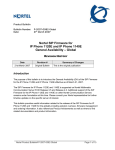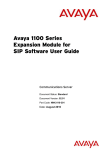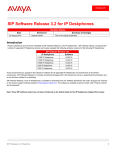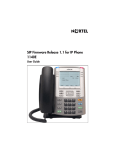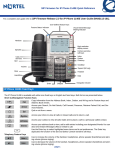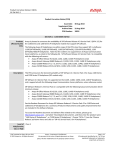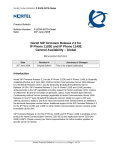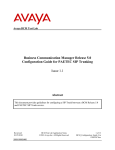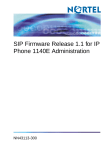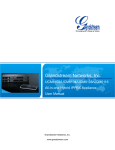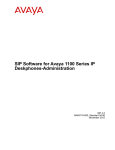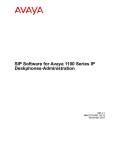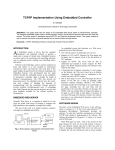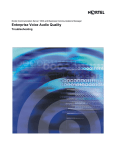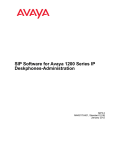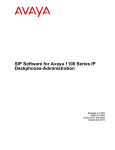Download Avaya SIP Software Release 3.0 Notice
Transcript
avaya.com SIP Software Release 3.0 for IP Deskphones Revision History Date 9 August 2010 Revision # Original bulletin Summary of Changes This is the original publication Introduction Avaya is pleased to announce the availability of SIP software Release 3.0 for IP Deskphones. SIP software release 3.0 makes available the following software versions for the following IP Deskphones: SIP Software Release 3.0 IP Deskphone Software 1120E IP Deskphone 03.00.65 1140E IP Deskphone 03.00.65 Avaya recommends an upgrade to this release of software for all applicable IP Deskphones and Call Servers at the earliest convenience. SIP software Release 3.0 for IP Deskphones is available for download from the “Software Download” link under “Support and Training” on the product support website located at: http://support.nortel.com. The software is available by phone model under “Phones, Clients and Accessories”. Note: These SIP software loads have not been introduced as the default loads for the IP Deskphones shipped from Avaya. SIP Release 3.0 Readme 1 avaya.com Enhancements Several enhancements have been included in SIP Release 3.0 for the 1100-Series phones including User Interface and Preferences enhancements, Multi-user Login, Emergency Services support, USB device support, Wide-band Codec, Provisioning and Licensing. User Interface and Preferences Enhancements Based on user feedback, the user interface for the SIP 3.0 software on the 1100-Series phones has been significantly improved. Menus are more responsive and commonly used features and functions have been moved to the main screen, including: - Transfer (blind and consultative) - Conference (local and conf server) - Call Fwd - Call Park - Audio Other enhancements include: • Context-sensitive soft keys • Services menu changes • Menu Auto Back-out timer (configurable) • Modifications for Inbox and Outbox. Operation is now more intuitive. For example, users can now get call details by pressing the Right Navigation key. • Customizable Banner for login allows display of corporate logos or messages • Phone Information Details screen • Screensaver/Screen lock • Background Images • Call Server Service Package Group Support • Speed Dial List • Password ‘blanking’ on entry • Busy Lamp Field support • USB Flash memory device support Multi-user Login The Multiuser feature in SIP Release 3.0 allows multiple SIP user accounts to be in use on the IP Deskphone at the same time. Multiple users, each with their own account, can share a single IP Deskphone allowing each user to receive calls without logging off other users. One user can have multiple user accounts (for example, a work account and a personal account) active at the same time SIP Release 3.0 Readme 2 avaya.com on the same IP Deskphone. You can register each account to a different server, and for each account, the IP Deskphone exposes the functionality available to that account. One account is considered a primary account and is used by default for most IP Deskphone operations. Each account is associated to a line key; the primary account is always on the bottom right line key of the IP Deskphone (this is the first key, Key 01), and an arbitrary key (including a key on an Expansion Module) can be selected for additional accounts. The following operations are supported: • Start dialing • Place a call using the corresponding user account • Answer an incoming call targeted to that account • Initiate a call without pressing a line key (for example, by dialing digits at the idle screen and lifting the handset) uses the primary account. A running IP Deskphone is associated to a single profile that represents one configuration of the IP Deskphone with all relevant persistent data such as preferences and call logs. A different profile is associated to each account used as a primary account. The IP Deskphone can store up to five different profiles; the IP Deskphone takes data from the profile associated to the current primary account. A number of configurations are independent of profiles and tied directly to an account making them available to that account regardless of the primary account you use (for example, voice mail ID). The IP Deskphone receives and answers calls targeted at any of the registered accounts; the incoming call screen indicates who the call is for. You can place an outgoing call using any of the accounts; the account that you use is displayed on the dialing screen. When a call is active, information from both local and remote parties appear on the screen. Regardless of which account receives the call, incoming call logs, outgoing call logs, and instant messages appear in a single list. The IP Deskphone indicates the local user in the detailed view of the entry. Some features are only available to the primary account, such as instant messaging, retrieving parked calls by token, and establishing ad-hoc conference calls. Emergency Services Enhancements / E911 Support SIP Release 3.0 enables users of Avaya 1100-Series IP Deskphones to make an emergency call to the Public Safety Answering Point (PSAP), from any screen, without a user being logged on. When connected to the PSAP, the IP Deskphone conveys the caller’s location information to the PSAP (if the network supports this feature). If you are not logged on to the IP Deskphone and you pick up the handset or press the handsfree or headset button, the message “Emergency calls only” appears on the screen of the IP Deskphone. If you hang up before the connection is established, the IP Deskphone goes back to the initial state. After the connection is established, the call can only be released by the Public Safety Answering Point (PSAP). If you hang up, the IP Deskphone switches to loudspeaker. If the IP Deskphone is already on the loudspeaker mode, and you press the hang up button, nothing happens. The call is still connected and can only be disconnected by the emergency operator. Emergency calls originate on the IP Deskphone and are completed by the Call Server. The Call Server communicates with the emergency network or emergency systems for routing, call control, and location information. Although the IP Deskphone allows the user to enter location information, this location information is not used by all Call Servers. Some Call Servers derive the location information based on the number and location databases. Characteristics of emergency calls and limitations of emergency calls using the IP Deskphone are as follows: SIP Release 3.0 Readme 3 avaya.com • Making calls without logging on is only allowed for emergency calls (according to the defined dialing plan). • Transmission of the location information depends on support of the proxy and the network. USB Headset support With SIP Release 3.0, USB headsets are supported Avaya IP Deskphone 1100-Series IP Deskphones. The Avaya IP Deskphone 1100-Series IP Deskphones also support Wideband audio on USB headsets. Avaya has implemented support for the Human Interface Device (HID) of the following wireless USB headsets: - GN Netcom GN9350e USB - Plantronics CS50-USB and CS60-USB Compliance to the their HID allows the IP Deskphone to recognize call controlling features from the headset including off-hook (call answer/initiate), on-hook (call release), mute, and volume control. USB Headset support also allows the Avaya Mobile USB Headset Adapter to be used with the IP Deskphone. This includes support for the associated answer (off-hook), release (on-hook), mute and volume keys on this adapter. Licensing SIP Release 3.0 introduces a licensing mechanism that uses a new and more flexible “Tokens” structure to enable a feature or set of features on a per device or user basis. Licensing allow for both local (“node-locked”) and network level (“network-locked”) based licensing options to meet varying size deployments/different customer requirements. This licensing mechanism enables customers to upgrade IP Deskphone-based (local) software feature improvements outside of call server releases. Node-locked licenses are associated with the Media Access Control (MAC) address for each IP Deskphone. One node-locked license is required for each phone on the network. Network-locked licenses are associated with a Site. A single network-locked license may be applied to all IP Deskphones in the network up to the total number of licensed devices. All phones in the network share the same feature set as described below. Two levels of feature packages are available with SIP Release 3.0: Standard and Extended The NTYS01JAE6 (N0214980) IP Clients SIP Standard Feature package includes the following feature grouping: - SIP Core Features (RFC3261 and SIPPING 19) - 3-way calling and conference calling - Audio codecs - standard - Auto Login and Auto Logout - Background Images - Busy Lamp Field (BLF) - Distinctive ringing - Downloadable ringtones - Image screensaver and lock - Standard font languages - Multiple calls per user - Server failover redundancy SIP Release 3.0 Readme 4 avaya.com - Session timers - SNTP (time server) - Speed Dial List - Transfer to Voice Mail softkey - USB flash drive In addition, the NTYS01KAE6 (N0214981) IP Clients SIP Extended Feature package adds the following features: - Standard features - Bluetooth headset support (1140E) - Call Server Service Package - Expansion Module support - Instant Messaging - NAT Traversal/STUN - Proactive Voice Quality Management - PC Client Control - USB headset support for audio - IPv6 support - Broadsoft Broadworks SCA Licenses are obtained through the Keycode Retrieval System (KRS). You must register for access to KRS. Detailed information regarding the process on obtaining licenses for SIP Release 3.0 may be found in the KRS User Guide. To login to KRS and access the KRS User Guide: 1. Go to http://www.nortel.com/support/tools/krs 2. Click Online Self-Service 3. Select Keycode Retrieval System 4. Select GLOBAL LOGIN from the list for the login location that you would like to use for access to the Keycode Retrieval System. 5. Select IP CLIENTS from the list for the product whose keycodes you would like to access. 6. When registration is validated, go tohttp://www.nortel.com/support/tools/krs and login in to KRS. 7. To view the KRS User Guide, select Product family > Documentation > Forms and User Guides > KRS IP Clients User Guide_v2.ppt. Further information regarding the operation and administration of licenses in SIP Release 3.0 can be found in the associated administration guides: • NN43112-300 SIP Software Release 3.0 for IP Phone 1120E Administration • NN43113-300 SIP Software Release 3.0 for IP Phone 1140E Administration SIP Release 3.0 Readme 5 avaya.com SIP Release 3.0 Readme 6 avaya.com Quality Improvements The SIP software Release 3.0 for IP Deskphones also continues to improve the overall quality of the IP Deskphone software through the delivery of ongoing resolution of CRs. Numerous quality improvements have been delivered and N customer cases have been closed in SIP 3.0. SIP software Release 3.0 for IP Deskphones closes the following customer cases: Closed Cases Description Case Id 30 Minute Delay for MADN Subscription after Registration 1100 Phone Does not Recognize 2nd DNS Server 1100 Phone Crashes After Speed Call Key is Pressed Repeatedly Display issue … MADN key labeling limited to 10 digits – customer using 11-digit number plan IP Phone 1120: DSCP values are not set correctly for media or control payloads DNS failover …. If a primary DNS server is unavailable, the 1100 phone fails to retrieve a service package from the secondary DNS upon reboot. MADN issue … Call failure when try to answer a call on a non-primary MADN appearance. EAP Logoff: SIP 3.0 phone does not always send correct EAP-Logoff packet 100519-47736 100520-48372 100603-54675 100511-43242 100505-40578 100521-49010 100520-48372 100518-46875 100125-87603 IP Deskphone Compatibility SIP software Release 3.0 for IP Deskphones is compatible with the following IP Deskphones: IP Deskphone Compatibility PEC NTYS03xxxxxx NTYS05xxxxxx Description 1120E IP Deskphone 1140E IP Deskphone Software File SIP1120e03.00.65.00.bin SIP1140e03.00.65.00.bin Call Server Compatibility and Requirements SIP software release 3.0 is compatible with the Call Servers listed below. Genband (Nortel) CS2000 CVAM 13 C20, CVAM 14 Genband (Nortel) AAE 7.0, 7.1 SIP Release 3.0 Readme 7 avaya.com References and Related Documents SIP Release 3.0 for IP Phone 1120E and 1140E related documents are available on http://www.nortel.com/support using the following product path. Changes and Enhancements in SIP Release 3.0 have been documented in this product bulletin. For SIP on IP Phone 1120E: http://support.nortel.com/go/main.jsp?cscat=DOCUMENTATION&poid=15741 For SIP on IP Phone 1140E: http://support.nortel.com/go/main.jsp?cscat=DOCUMENTATION&poid=15721 SIP Release 3.0 for IP Phone 1120E and 1140E documentation includes the following materials: • NN43112-101 SIP Software Release 3.0 for IP Phone 1120E User Guide • NN43112-102 SIP Software Release 3.0 for IP Phone 1120E Quick Reference Card • NN43112-300 SIP Software Release 3.0 for IP Phone 1120E Administration • NN43110-301 Expansion Module for IP Phone 1100 Series (SIP Software) User Guide • NN43113-101 SIP Software Release 3.0 for IP Phone 1140E User Guide • NN43113-102 SIP Software Release 3.0 for IP Phone 1140E Quick Reference Card • NN43113-300 SIP Software Release 3.0 for IP Phone 1140E Administration • NN43110-301 Expansion Module for IP Phone 1100 Series (SIP Software) User Guide SIP Release 3.0 Readme 8 avaya.com Product Advisements The following is a list of advisements associated with SIP software release 3.0. Some advisements remain from previous releases of software, whereas other advisements reflect new or changed behavior introduced with SIP software release 3.0. Advisements that are new to SIP software release 3.0 or have changed since previous releases of SIP software are prefixed with “NEW”. Audio Codec Enhancements SIP Release 3.0 for IP Phone 1120E and 1140E expands support of the existing G729a codec with Annex B G729b codec (comfort noise generation) and adds support for G723.1 (high-compression codec) codec. SIP Release 3.0 for IP Phone 1120E and 1140E supports selection of audio codec list as below via the device configuration file. For details on the configuration files, please refer to the Administration guides. SIP Release 3.0 for IP Phone 1120E and 1140E supports existing Administrative setting of DEF_AUDIO_QULITY (high/med/low). The device configuration flag shown below for codec list selection continues to be supported in SIP Release 2.2 for IP Phone 1120E and 1140E: ENABLE_ALTERN_CODEC_LIST YES/NO When ENABLE_ALTERN_CODEC_LIST is set to NO, the IP Phone uses the list of codecs below: High: ptime = 20 ms : G711, G729 Med: ptime = 30 ms : G711, G729 Low: ptime = 30 ms : G729, G711 When ENABLE_ALTERN_CODEC_LIST is set to YES, the IP Phone uses the list of codecs as below: High: ptime = 20 ms : G711, G729 Med: ptime = 20 ms : G729, G711 Low: ptime = 40 ms : G729, G711 Thus G729 20ms or 40ms can be selected as default value and may be suitable for certain networks requiring bandwidth optimization. Note that when using “Audio_Codecx”, these settings are ignored. This is primarily for “legacy” support. Security – NAT Traversal & STUN protocol The SIP Release for IP Phone 1120E and 1140E supports two methods for NAT traversal of the signaling path: • SIP_PING • Simple Traversal of User Datagram Protocol through Network Address Translators (STUN) SIP PING is a Avaya protocol for NAT traversal for SIP signaling only. The STUN protocol lets a client discover the presence and type of NATs between the client and the public Intert. In addition, a client can discover the mapping between the private IP address and port number and the public IP address and port number. Typically, an Enterprise or a service provider operates a STUN server in the public Internet or internet domain. A STUN server can be located using DNS SRV records using the domain as the lookup. STUN typically uses the well-known port number 3478. The NAT traversal method can be selected manually through the Device Settings menu or configured through the device configuration file. SIP Release 3.0 Readme 9 avaya.com SIP Release 3.0 for IP Phone 1120E and 1140E also supports NAT traversal for the Media path. However, STUN protocol cannot coexist with Application Layer Gateway (ALG), Media Portals or RTP Proxy servers. If STUN is configured on the SIP Release, ensure none of these devices are configured in the SIP proxy server. 802.1X and Extensible Authentication Protocol (EAP) SIP Release 3.0 for IP Phone 1120E and 1140E supports 802.1 X/EAP device authentications. The authentication protocol currently supported is EAP-MD5. Customers need to procure appropriate RADIUS/authentication servers (both HW/SW). Certificate based authentication is planned for a future release. Shared Call Appearance SIP Release 3.0 for IP Phone 1120E and 1140E supports Shared Call Appearance Feature. The Shared Call Appearance feature allows a given line to be configured with multiple locations, essentially allowing multiple endpoints to login to the system while using the same external number. Any one of these locations can be used to originate or receive calls. Any call appears to the other party to be originating from or terminating to the same number, regardless of the location initiating or receiving the call. The Shared Call Appearance feature allows a user to pick up a call that was put on hold by another user of the same group and it allows a user to join an active call of another user in the group. The Shared Call Appearance feature is supported on Broadsoft BroadWorks server. SIP Release 1.1 and above for IP Phone 1120E and 1140E supports Multiple Appearance Directory Number (MADN) Single Call Appearance (SCA) feature for Genband (Nortel) Communication Servers CS2000 and CS2100. SIP URI Dialing SIP Release 3.0 for IP Phone 1120E and 1140E supports URI dialing. Some Communication Servers may not support URI dialing and in such cases, attempt to make calls from the Call softkey menu of SIP may not complete and users may get an error message. In addition, as a valid URI is to be entered for monitoring a user’s presence state the presence state/updates may not be reflected accurately with Communication Servers that may not support URI. Expansion Module SIP Release 3.0 for IP Phone 1120E and 1140E supports the Expansion Module. The Expansion Module is a hardware accessory that connects to the IP Phone and provides additional line appearances and feature keys. Up to three expansion modules are supported. The IP Phone 1120E and IP Phone1140E can have up to 54 additional line/feature keys with three Expansion Modules. The Expansion Module is equipped with a graphical, pixel-based, grayscale LCD display area beside the 18 line/feature keys. Each of the 18 physical keys on the Expansion Module has a 10-character display label. This label is set automatically, however, the user can edit the label using the controls on the IP Phone. The Expansion Module will display similar graphics for the key label and icons as displayed on the IP phone. Programmed keys are stored in the user profile. Each user will be able to maintain his/her list of programmed feature keys. You can program the feature keys as Speed Dial, Presence, Send IM, Call Forward or Do Not Disturb. The user has the ability to automatically populate the unused Expansion Module feature keys, using the friends list or the address book as sources. There is no specific dependency on call server for the Expansion Module to be functional. However, friends list and presence notification are call server dependant and may require changes to the user package of your IP Phone. Distinctive ringing and Call waiting The Distinctive ringing feature permits users to distinguish between different types of call actions by playing a different ringing pattern. The request for a specific ringing pattern comes from the server at the time the call is being established. The Avaya IP Phone 1140E with SIP software does not request the playing of distinctive ringing from other parties. The ringing patterns to be used follow the North American standards which also include call waiting tones for the times when the receiving end is already engaged in a call session. The predefined ringing pattern identifiers available on the phone accommodate usage by the Communication server. SIP Release 3.0 Readme 10 avaya.com IEEE 802.1ab Link Layer Discovery Protocol Discovery protocols provide a mechanism to identify devices attached to a network. Popular network-management systems use automated discovery to obtain the topology of a network. These applications detect adds and removals, provide Layer 3 information, and group the attached devices into IP subnets. IEEE has developed 802.1ab Link Layer Discovery Protocol (LLDP), a standard for discovering the physical topology between neighboring devices. 802.1ab LLDP defines a standard method for Ethernet network devices such as switches, routers and IP Phones to advertise information about themselves to other nodes on the network and store the information they discover in a MIB. This feature implements 802.1ab and its IEEE 802.1/802.3 and LLDP-MED specific extensions. Auto Login and Per Phone Configuration SIP Release 3.0 for IP Phone 1120E and IP Phone 1140E supports downloading a user’s login credentials from a central repository. The login credentials are associated with the MAC address of the particular IP Phone. This feature simplifies installation of the IP Phone by allowing it to automatically log into the SIP proxy server without end user intervention. Please refer to the Administration Guide for details on this feature and provisioning this capability. Before the user first receives the IP Phone 1120E or 1140E, the system administrator may configure the IP Phone with the user’s login id and password. If the IP Phone is configured with automatic login, the user cannot use the logout function and may need a password to access some features and functions of the SIP software. In addition, the administrators can provision specific features for users using the configuration files based on the MAC address of the IP Phone. RFC support enhancements (RFC 3262, RFC 3311, RFC 3581) RFC 3262 & 3211:The combined support of PRACK and UPDATE allows the IP Phone 1140E with SIP software to provide reliability to provisional responses, and the ability to update session parameters during call setup as well as after the initial invite has received a final response. The combination of reliable provisional responses (PRACK) and the ability to change session before call establishment (using UPDATE) will improve the IP Phone 1140E interactions with some PSTN networks where the parameters of a session may need updating before the call is established. To provision this feature please refer to the Administration Guide listed in the reference documents section. RFC 3581: This feature implements an extension to SIP for Symmetric Response Routing for the IP Phone 1140E with SIP software. This extension permits the conduction of SIP dialogs through a Symmetric Network Address Translator (NAT) using UDP. This allows the phone to work from behind and/or in front of a symmetrical NAT with servers and/or clients that support RFC 3581. In particular, it enhances the capability of the IP Phone 1140E and IP Phone 1120E with SIP software to interoperate with other proxies and to work in any network configuration. For this feature to work properly, the receiving end device must support RFC 3581.To provision this feature please refer to the Administration Guide listed in the reference documents section. RTP port configuration The SIP Release 3.0 for IP Phone 1120E and 1140E provides option to set or change RTP ports. RTP port configuration is available only through the provisioning server. Voice Quality Monitoring (VQMon) The SIP Release 3.0 for IP Phone 1120E and 1140E provides support for monitoring voice quality in conjunction with a Avaya Communication Server and a Telchemy 3rd party server. When Voice Quality Monitoring (VQMon) is enabled in the SIP software, the SIP software gathers statistics regarding the quality metrics of the current call and sends reports to the Avaya Communication Server/Telchemy 3rd party server at regular intervals. The voice quality-related statistics include jitter, packet loss, delay, burst gap loss, listening R-factor, R-LQ, R-CQ, MOS-LQ and MOS-CQ. This report can be used for QoS monitoring. A Telchemy server is required to collect and organize the data. SIP Release 2.2 for IP Phone 1140E and 1120E can interwork with Telchemy SQmediator 1.1. Please note customers are required to procure necessary Telchemy hardware and Telchemy SQmediator Software directly from Telchemy. http://telchemy.com SIP Release 3.0 Readme 11 avaya.com Transfer to Voice Mail The SIP Release 2.2 for IP Phone 1120E and 1140E supports “The transfer to Voice Mail” feature. This feature enables a soft key to transfer an incoming call, or a call waiting, to a voice mail box. The transfer to Voice Mail feature is supported on MCS 5100 server. Conferencing without Service Package This feature provides conferencing configuration parameters to the SIP client when using a call server such as the CS1000, where service packages are not supported. When SIP Release 2.2 for IP Phone 1120E/1140E is registered with MCS 5100, some services are dependent on service packages received from the server. When the IP Phone registers with MCS5100, it sends various subscriptions and one of them is for service package. Some servers like Communication Server CS1000 do not support service packages, in such cases below device configurations parameters can be used to support Adhoc conferencing capability. Also Domain Setting UI is enhanced to configure the Conference URI and the Max Adhoc Ports. o ENABLE_SERVICE_PACKAGE: YES or NO (Yes -> Phone will try to download service package, No -> phone will not subscribe to service package. Default: YES) Administrator can also configure the following values for each of the domains in the device configurations file: o CONFERENCE_URI1 : This field will contain conference URI. Ex: CONFERENCE_URI1 [email protected] o ADHOC_ENABLED1 : YES or NO (YES -> The call server supports ad hoc conferencing, NO-> Ad hoc conferencing is not supported by the Communication Server). This is required when the calls are being transferred to the Communication Server for ad hoc conferencing. o MAX_ADHOC_PORTS1 : values 0 - 4. This indicates the maximum number of users supported for ad hoc conferencing on the Communications Server. This value should be the same as configured on the Communication Server. 4 is the limit on MCS5100, as well as CS1000/SMCe. NOTE: When ENABLE_SERVICE_PACKAGE is turned on, rest of the parameters are ignored. They are taken from the available service package. Dial from Inbox Dial from Inbox allows the user to edit the number obtained from inbox before calling. SIP Release 3.0 Readme 12 avaya.com A new Edit menu is introduced which helps the user to prefix/edit the number. This Edit menu can be navigated through the Edit softkey of Answered/Missed Call menu, which presents the number with a cursor at the beginning to add the prefix. Navigating through the digits and inserting the digits in beginning, middle or end is also supported. A delete softkey is also introduced to delete the digits typed. Following are the changes made in SIP Release 2.2 • The Answer Softkey is removed and replaced by View. Selection of the View softkey shows the calls and time when the call was received. • used. The “Save” softkey in View and Missed Calls menu, has been removed. To save in the address book the "Copy" Key can be Logout without Password The logout procedure in SIP Release 2.1 was to go to Settings and Select Logout option. This displays a new screen asking ‘Enter Password to Logout’. The user was supposed to enter password and then press Ok. In SIP Release 2.2 when logout without password is enabled and the user selects Logout, the user sees a new screen which displays ‘Enter Ok to Logout’ and there will be no prompt for user to enter password. When user presses ok, there is no validation and the user is logged out of the set. This feature is enabled in the Device configuration file. The parameter as shown below is added to enable logout without password capability o LOGOUT_WITHOUT_PASSWORD’: YES or NO Avaya Automatic QoS When SIP Release 3.0 for IP Phone 1120E and 1140E is deployed with Avaya switches, a better treatment for signaling and media packets is provided. Avaya devices will use private DSCP values to give better treatment to the traffic coming from a peer Avaya device. With SIP Release 3.0 for IP Phone 1120E and 1140E, there are 3 methods to configure QoS for media and signaling packets 1)Through device configuration file, 2)LLDP (MED) and 3) Through service package. If none of the above 3 methods are used, system default DSCP values will be used. To implement this feature, a new checkbox to enable (and disable) Avaya Automatic QOS is added to the device settings UI. Also, 2 more fields to configure DSCP values for media and signaling are introduced in the device settings UI. The precedence of taking QoS values will be as follows: Service package, Avaya Automatic QOS, LLDP, Device settings UI and finally device configuration file. If none of them are configured, default DSCP values will be used. SIP Release 3.0 Readme 13 avaya.com User configured DSCP values and Avaya Automatic QOS feature will work in conjunction with user configured control and media priority bits (as is) since later is in layer 2 (VLAN ToS) and the former will be in layer 3, IP. The Device configurations file change is given below. The following flag is added to toggle the Avaya on Avaya feature: • NORTEL_Automatic_QOS: YES or NO (YES: Phone will use private DSCP values, unless overridden, NO: Phone will either use one of the configured DSCP values or the system default values) Password protection management for Domains In SIP Release 2.1 at the login screen, choosing domain is protected by admin password. The enhancement is to remove the password query for switching domains. Admin password protection will continue to protect the editing of the domains. Editing domain option is available at the following states, and it is required to enter the admin password for accessing the domain menu. a) Current Domain state b) Domain List state An exception to the above is when an attempt is made to edit the domain from the server settings. There will be no prompt for admin password since the user would have entered the admin password to enter the server settings menu. Editing domain menu interface will be displayed only when the correct admin password is entered by the user. Otherwise the user interface will display an “incorrect password” message and provides a prompt to retry. Pressing “back” at edit menu or at the password prompt, will get back to the display screen which was active before the password query. Once the user is out of the Edit mode, pressing Edit should again query for Admin password. Secure Digits while in call When users try to access voicemail by dialing the voice mail number, it is desirable the typed digits be not displayed as a plain text, it should rather be displayed as an asterisk or a dot ). An administrator defined configuration flag (SECURE_INCALL_DIGITS) is provided for setting the feature on or off. The feature will come in effect only when the call is active. Most recently pressed key will be displayed but overwritten when next key is pressed. The user has the option to hide or unhide the digits typed and next digits which he/she is going to press, if flag is set to YES otherwise by default digits will be displayed. DHCP When a DHCP server has to issue a new IP address to the IP Phone 1120E or 1140E after a lease expires, the IP Phone may go through a reboot and recover process and this process may take up to five minutes for the IP Phone to get back to its ready state to SIP Release 3.0 Readme 14 avaya.com make/receive calls. In addition, if a user is on a call, the call may be dropped and the IP Phone may go through the reboot and recover process. If the DHCP lease expires, the IP Phone must initiate a new negotiation of an IP address from the server's pool of addresses. DHCP lease may expire so the network does not run out of IP addresses or due to instability in the network. DHCP lease expiration is not a common event. Audio Headset Type Selection Support for high quality audio on 3rd party headset requires the ability for the users to select from a number of headset profiles. Selection of headset type will cause corresponding tuning parameters to be immediately usable by the IP Phone without having to reset the IP Phone. Users can select from the list of headsets from the Audio menu in the IP Phone. SIP Release 2.2 introduces headset selection in 'Audio' menu to support 3rd party headsets in the future. As part of this capability, Bluetooth headset selection is moved to Audio-> headset selection and must be selected before using the Bluetooth. IP Phone 1140E has Bluetooth capability. © 2010 Avaya Inc. All Rights Reserved. Avaya and the Avaya Logo are trademarks of Avaya Inc. and are registered in the United States and other countries. All trademarks identified by ®, TM or SM are registered marks, trademarks, and service marks, respectively, of Avaya Inc. All other trademarks are the property of their respective owners. Avaya may also have trademark rights in other terms used herein. References to Avaya include the Nortel Enterprise business, which was acquired as of December 18, 2009. 02/10 SIP Release 3.0 Readme 15

















